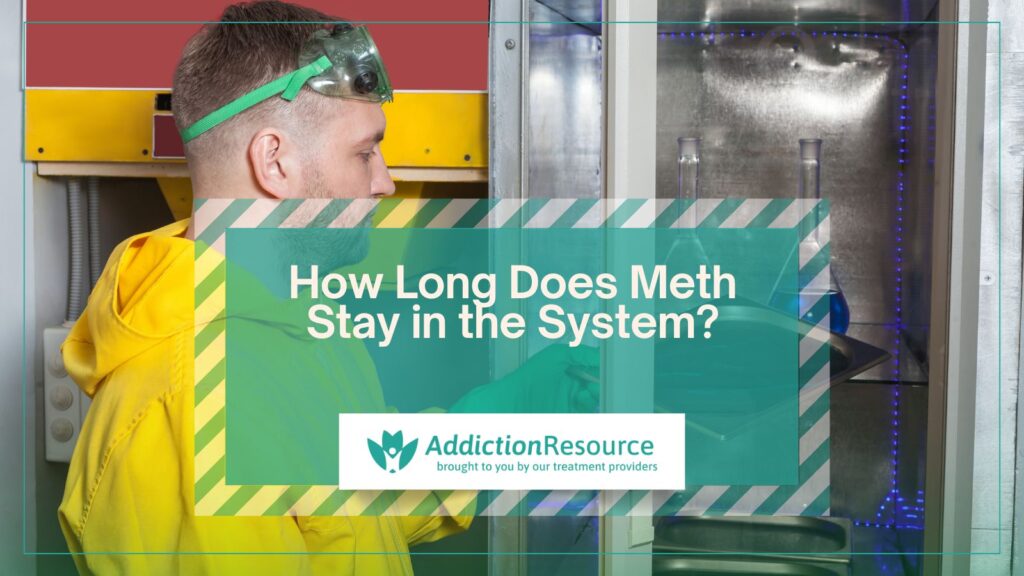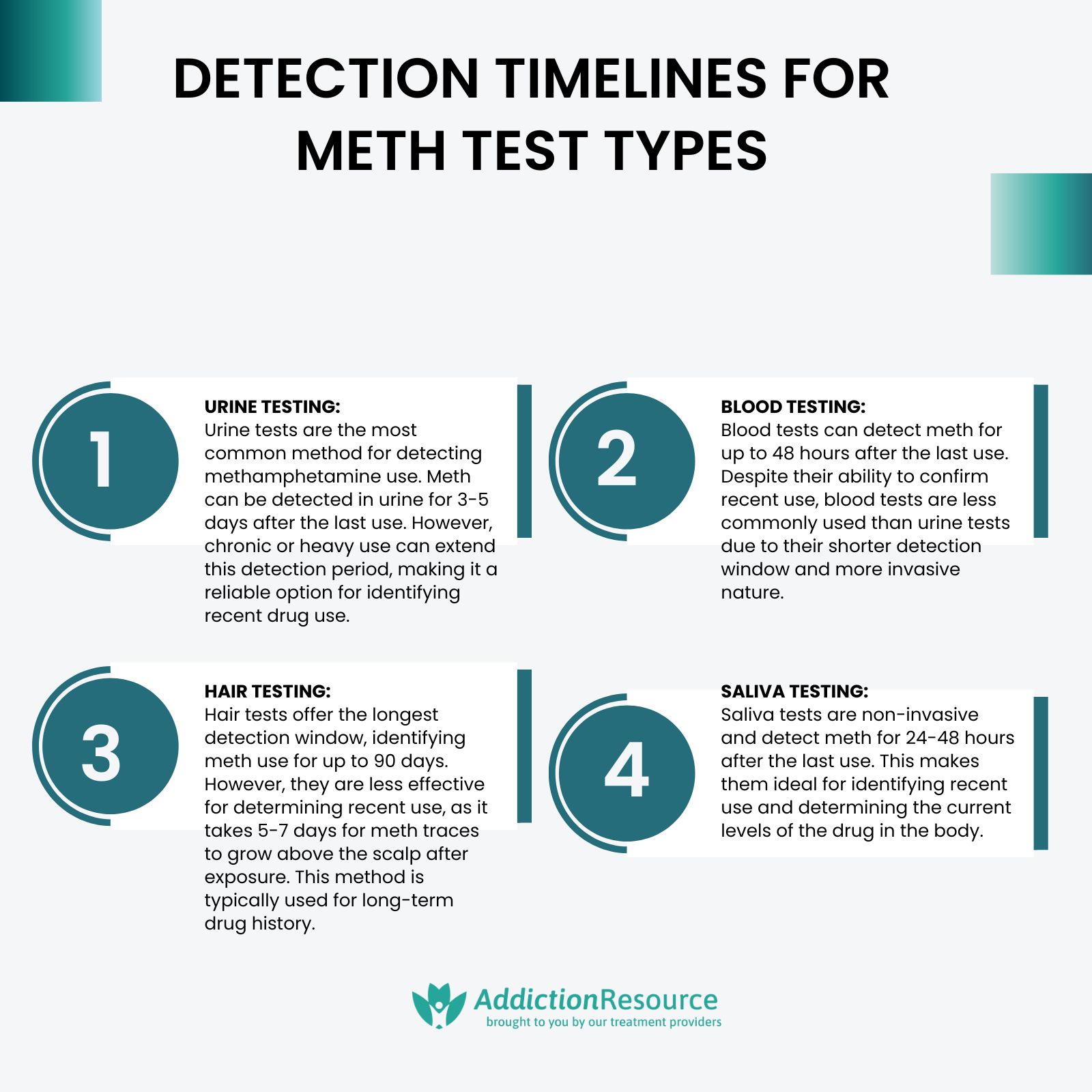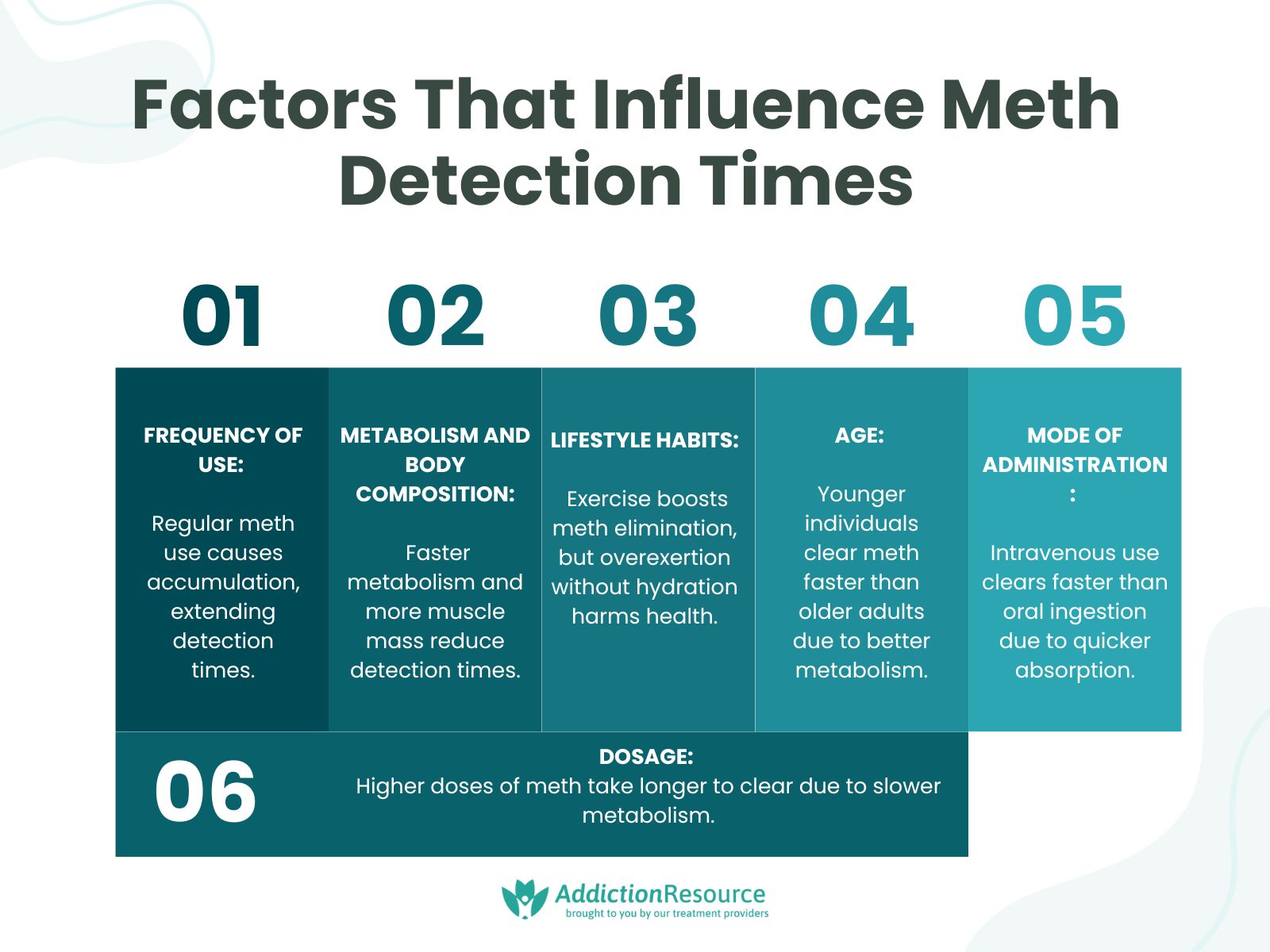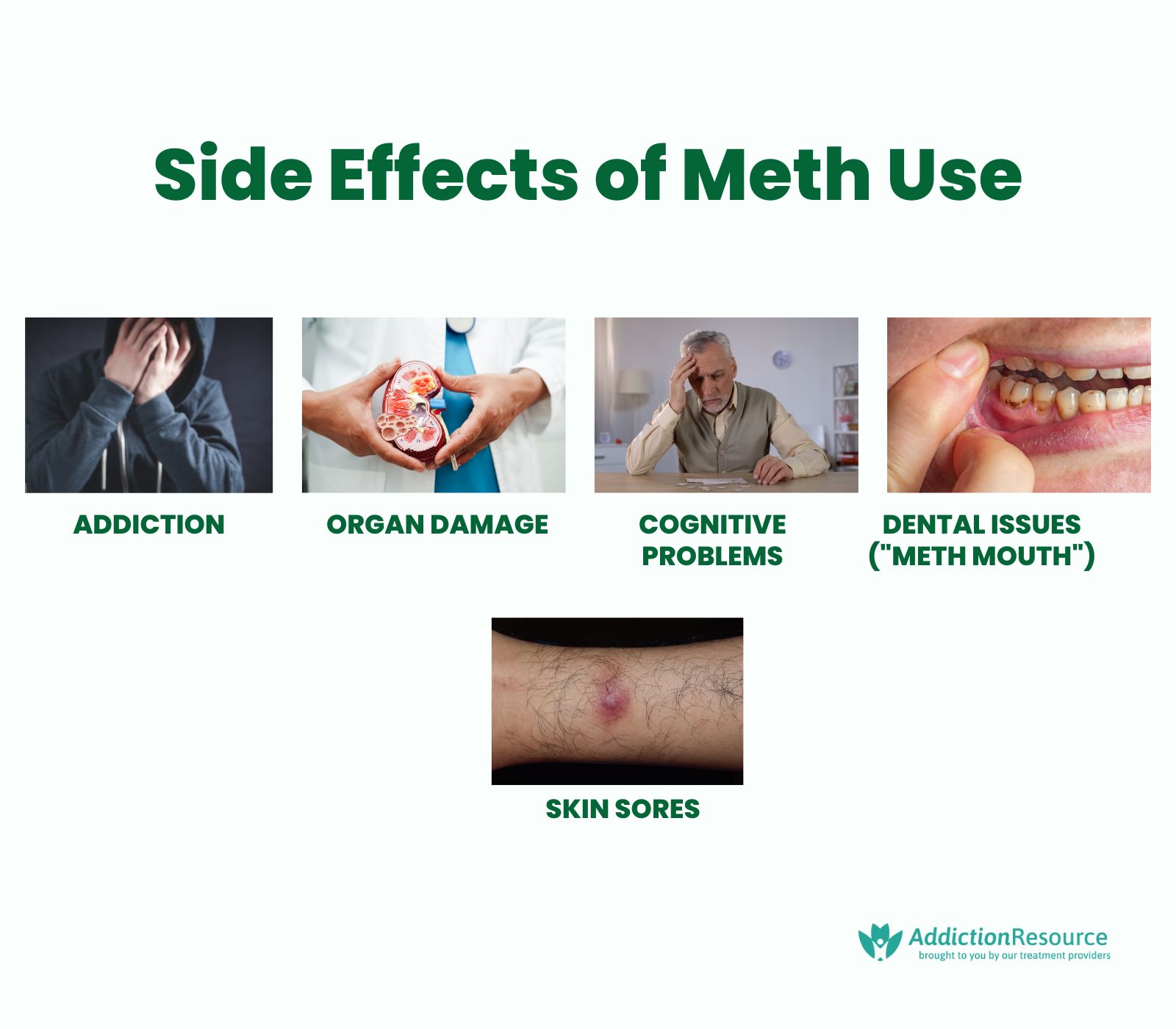
Methamphetamine (meth) stays in the system for 3 to 90 days, but its detection varies depending on the type of drug test and individual factors. Common tests to detect meth include urine, blood, saliva, and hair testing. Each test offers different detection timelines. Urine tests detect meth for 1-2 days (24-48 hours) or up to 7 days with heavy use. Blood tests detect meth for 1-2 days (24-48 hours), saliva for 1-2 days (24-48 hours), and hair for up to 90 days, according to an article written by Marilyn Ahuestis in 2009 titled “Methamphetamine Disposition in Oral Fluid, Plasma, and Urine.”
Table Of Contents:
Meth detection time is important because it helps in legal outcomes, employee screenings, and treatment decisions. Multiple factors affect the detection range, including dosage, metabolic rate, body fat percentage, hydration, and liver or kidney health. Chronic use and method of intake (smoking, injecting) extend the detectability of meth. It is important to understand these timelines for proper testing and effective health outcomes.
How the Body Processes Meth?
The body processes meth by rapidly absorbing it into the bloodstream, whether it’s smoked, snorted, ingested, or injected. Meth travels to the brain and other organs (once in the bloodstream), where it produces its stimulant effects. The liver plays an important role in breaking down meth into inactive metabolites, amphetamine and 4-hydroxymethamphetamine. These metabolites, along with the unmetabolized drug (meth), are then eliminated primarily through urine.
Meth has a half-life of 10-12 hours, which means it takes 10-12 hours for half the drug to leave the system. Its stimulating effects remain active in the system for up to 4 days, according to an article written by Medical News Today titled “Meth: How long does it stay in the system?” The elimination process of meth varies based on factors like metabolism, dosage, and frequency of use, with most traces detectable in urine for 1-4 days after last use, according to a research article written by Linghui Li in 2011 titled “A Method to Quantify Illicit Intake of Drugs from Urine: Methamphetamine.”
How Long Does Meth Stay in Your System?

Meth stays in the system for 3 to 90 days, depending on the testing method, such as urine, blood, hair, and saliva tests.
The detection timelines for these 4 main test types are listed below.
- Urine Testing: Urine tests are the most common way to detect methamphetamine. Meth is detected in urine for up to 3-5 days after the last use. Chronic or heavy use extends the detection period, according to an article published on UK Drug Testing titled “Drug Test Detection Times & Cut-Off Levels.”
- Blood Testing: Blood tests detect meth but are less common than urine tests. Meth is detectable in blood for up to 48 hours after the last use. Blood testing is less used for routine screening because of its shorter detection window (short time frame for detection).
- Hair Testing: Meth is detected in hair follicles for up to 90 days after last use. Hair tests provide a longer detection window but do not give evidence regarding recent use. Hair takes 5-7 days to grow above the scalp after absorbing meth traces.
- Saliva Testing: Meth is detectable in saliva for up to 24-48 hours (1-2 days) after the last use. Saliva tests are non-invasive and detect recent meth use, making them useful for determining the current amount of the drug, according to an article written by Amy Keller, RN, BSN, titled “How Long Does Meth Stay in Your System?”
What are the Factors That Influence Meth Detection Times?

The factors that influence methamphetamine (meth) detection times include dosage, frequency of use, metabolism and body composition, hydration, lifestyle habits, age, and the method of administration.
The 7 main factors that influence meth detection times are written below.
- Dosage: Dosage means the specific amount of drug taken at one time or over a certain period. Higher doses of meth saturate the metabolic pathways of the human body and lead to prolonged detection times. Larger amounts of meth require more time to be metabolized and excreted from the system.
- Frequency of Use: Chronic or frequent use of meth results in the accumulation of meth in the system and extends the duration of meth detection. Chronic meth users test positive for longer periods compared to occasional meth users.
- Metabolism and Body Composition: Metabolism is the process by which the body breaks down a drug into its metabolites. Individuals with faster metabolic rates process and eliminate meth more quickly. Factors such as higher muscle mass and lower body fat percentage enhance the metabolism of meth and reduce the detection times.
- Hydration: Adequate hydration helps the excretion of meth through urine. Proper hydration gives a high chance of shortening detection periods. Dehydration slows down the excretion process of meth.
- Lifestyle Habits: Lifestyle habits means the regular behaviors and routines people follow in their daily lives. Engaging in regular physical activity boosts metabolic rate and helps in faster elimination of meth. However, excessive exercise without proper hydration has adverse effects on the overall human health.
- Age: Younger individuals have more efficient metabolic processes, which leads to quicker drug clearance. Aging slows down the process of metabolism and extends the detection times of meth, according to an article written by Zia Sherrell, MPH, in 2022 on Medical News Today titled “Meth: How long does it stay in the system”?
- Mode of Administration: The route of meth intake (oral, inhalation, injection) affects absorption rates and metabolism. Intravenous meth intake leads to rapid absorption and results in shorter detection times compared to oral ingestion of meth.
What is the Half-life of Methamphetamine?
Methamphetamine has a half-life of 10 to 12 hours, which means it takes 10 to 12 hours for half of its concentration to be metabolized and eliminated from the system. The half-life depends on individual factors such as metabolism and liver function. The long half-life means that meth remains active in the system for several hours, resulting in extended stimulant effects, according to an article written by Debra S Harris in 2003 titled “The bioavailability of intranasal and smoked methamphetamine.”
The concept of half-life is important in meth detection because it helps to determine how long meth stays in the system. Urine tests identify meth for 1-2 days due to the slower excretion of metabolites. Blood and saliva tests detect meth only during its active phase or shortly after taking it. Hair tests detect meth use for up to 90 days and give insights about long-term use of meth rather than recent intake.
What are the Side Effects of Meth Use?

The side effects of methamphetamine include addiction, organ damage, cognitive problems, dental issues, and skin sores.
The 5 main side effects of crystal meth are listed below.
- Addiction: Addiction means a strong urge to use an addictive substance such as meth regularly. Meth is highly addictive due to its powerful stimulation of dopamine release in the brain. Meth users develop tolerance and require higher doses to achieve the same effects. The cycle leads to dependence, withdrawal symptoms, and compulsive drug-seeking behavior and makes it difficult to quit without support groups and behavioral therapies. Over 61% of meth users relapse within a year of treatment, according to an article written by Diane Herbeck in 2015 titled “Time to relapse following treatment for methamphetamine use: a long-term perspective on patterns and predictors.”
- Organ Damage: Meth causes a high risk of damage to vital organs, which is one of the major side effects of crystal meth. Long-term use strains the heart, increasing the risk of arrhythmias, heart attack, and cardiomyopathy. The liver and kidneys also suffer due to the toxic byproducts of meth metabolism, which leads to liver failure and chronic kidney disease. Meth-induced overheating (hyperthermia) causes multi-organ failure.
- Cognitive Problems: Cognitive problems mean difficulties with mental processes. Chronic meth use leads to structural and functional brain changes in areas responsible for memory, learning, and decision-making. Meth users experience memory loss, difficulty concentrating, and loss of motor skills. Long-term crystal meth users show a 10 – 20% reduction in brain volume in areas linked to memory and emotion, according to a study published by Carl L Hart in 2011 titled “Is Cognitive Functioning Impaired in Methamphetamine Users? A Critical Review”.
- Dental Issues (“Meth Mouth”): Meth mouth is a medical term used to describe severe dental problems due to methamphetamine use. Meth causes severe dental decay due to dry mouth, teeth grinding, and poor oral hygiene. The acidic nature of meth also contributes to enamel erosion. Meth users have cavities, with 96% affected, and 58% have untreated tooth decay, according to the American Dental Association journal written by Vivek Shetty, DDS, DrMedDent in 2015, titled “Dental disease patterns in methamphetamine users.”
- Skin Sores: Skin sores are open wounds or lesions seen in meth-addicts. Meth users experience hallucinations (formication), which leads them to pick or scratch at their skin and cause open sores. These sores are slow to heal due to poor nutrition and weak immune systems and make meth users prone to bacterial infections and scarring on the face and neck.
What is Crystal Meth?
Crystal methamphetamine, or “crystal meth,” is a potent and highly addictive central nervous system stimulant. Crystal meth is the hydrochloride salt of methamphetamine and looks like a clear crystal resembling ice. Crystal meth in powder form is smoked, allowing rapid absorption into the bloodstream and rapid onset of intense euphoria.
Meth exerts its effects by increasing the release of neurotransmitters such as dopamine, norepinephrine, and serotonin. The release of these neurotransmitters leads to heightened alertness, increased energy, and a sense of well-being. Meth use carries health risks, including addiction, cardiovascular problems, and neurotoxicity, according to a journal published by the Canadian Medical Association in 2008 titled “Pharmacologic Mechanisms of Crystal Meth.”
How long does meth stay in urine for a heavy user?
Methamphetamine stays in the urine of a heavy user for up to 7-10 days after the last use. The duration of staying in the system depends on metabolism and hydration levels. Meth metabolizes in the liver and is excreted through urine. Meth is detectable for a longer period in heavy users due to accumulation from chronic use. Testing methods, such as immunoassay screenings or gas chromatography, also play a role in the detection duration of meth, according to an article written by Jae Chul in 2003 titled “Screening method for the detection of methamphetamine in hair using fluorescence polarization immunoassay.”
The dangers of meth include its highly addictive nature, severe mental health effects like paranoia (suspicion) or aggression. Meth overdose causes cardiovascular damage leading to heart attacks and long-term physical effects such as dental decay (meth mouth) and skin sores.
Can you detect meth in hair after one use?
Yes, meth is detected in hair after a single use. Hair follicle tests are highly sensitive and trace meth use over a long period, up to 90 days. The duration of detection depends on the length of the hair sample. Hair tests show a history of drug use, and even using meth once leaves a trace that is detected. Meth incorporates into the hair shaft through the bloodstream during hair growth.
Do meth and heroin have the same detection times?
No, meth and heroin do not have the same detection times, as their metabolism and excretion rates are different. Meth is detected in urine for 2-5 days, and heroin is detectable for 1-3 days in urine. Meth is detectable for 1-3 days in the blood, and heroin for a few hours to 1 day. Both substances are detected for up to 90 days in hair tests.
How to pass a drug test for meth?
The only way to pass a drug test for meth is to stop using meth and allow enough time for it to be naturally eliminated from your body. The withdrawal process depends on individual metabolism, hydration levels, and frequency of use. Meth takes 3-10 days to clear the urine for heavy users.
What is crystal meth withdrawal?
Crystal meth withdrawal means the set of symptoms experienced when a meth addict stops using meth. These symptoms occur because the body and brain adjust to the absence of the drug, which previously overstimulates the central nervous system. Common crystal meth withdrawal symptoms include extreme fatigue, intense cravings, depression, anxiety, irritability, and sleep disturbances such as insomnia or oversleeping. Physical symptoms include increased appetite, muscle aches, and psychomotor slowing. Crystal meth withdrawal lasts from a few days to weeks. The most intense withdrawal symptoms occur in the first 24-48 hours.
Can secondhand meth smoke show up on a drug test?
No, secondhand meth smoke doesn’t show up on a drug test. The amount of methamphetamine inhaled passively is too small to be detected in drug tests. Long-term exposure to heavy secondhand meth smoke in a confined space leads to trace amounts being detected. It is advised to avoid places where meth use occurs to eliminate even minimal risk and other associated risks of secondhand meth exposure.
What is the longest time that meth can stay in the body?
The longest time meth stays in the system is 90 days, and it is detectable through hair tests. Meth stays in the blood for up to 1-2 days and in urine for 2-5 days. Chronic or heavy users experience longer detection times in urine due to drug accumulation in their system. Crystal meth’s half-life is 10-12 hours. However, heroin withdrawal begins within hours of the last dose, which means it takes less time for heroin withdrawal and detoxification. The residual traces of the drug remain in the system for extended periods.
Find Drug Rehabilitation Centers Near You Anywhere In the US
Addiction Resource team has compiled an extensive list of the top drug rehabilitation facilities around the country. Use our locator tool to find the best centers near you.


 Reviewed by:
Reviewed by: 

 FindTreatment.gov
FindTreatment.gov